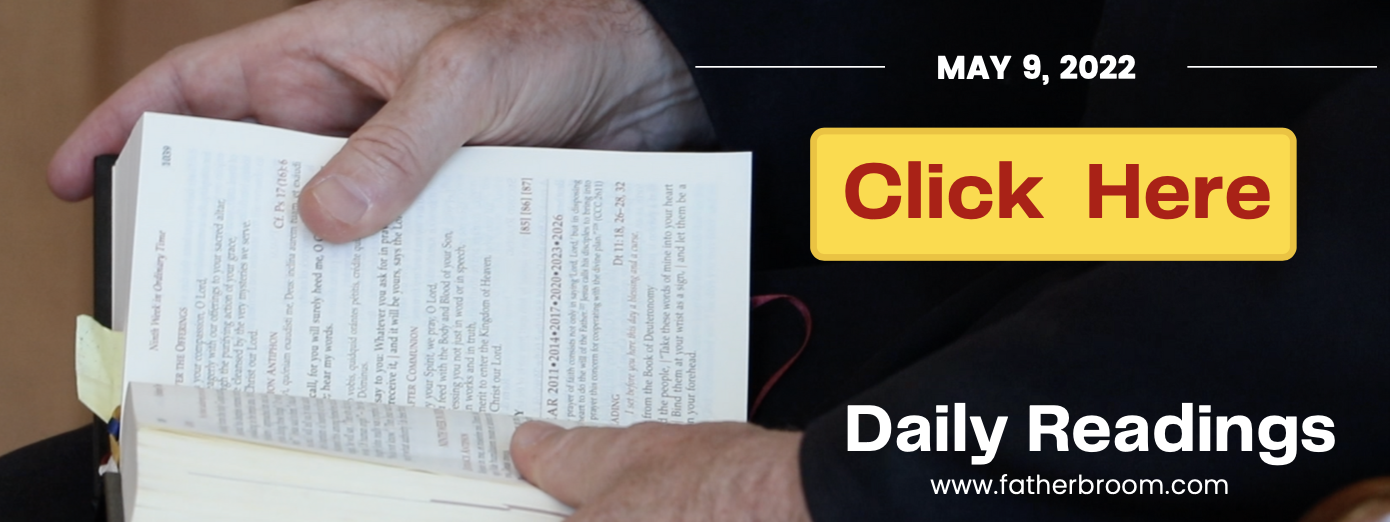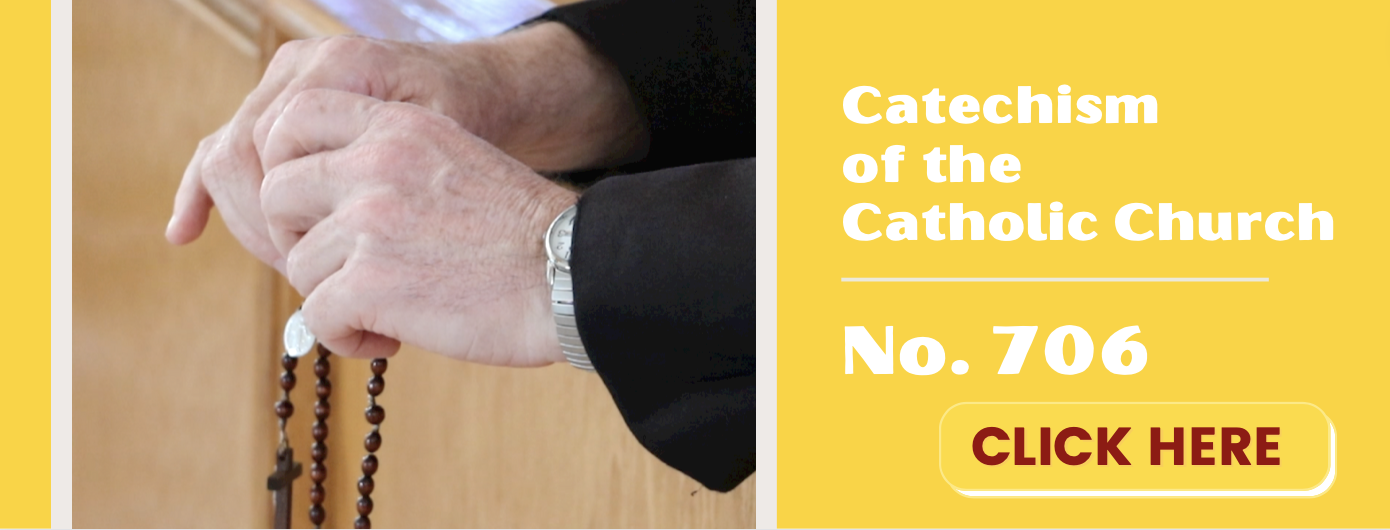Monday of the Fourth Week of Easter



“For greater things you were born.” (Ven. Mother Luisita)
MONDAY, May 9th Jn 10: 1-10 Alleluia Verse: “I am the Good Shepherd, says the Lord; I know my sheep, and mine know me.”
Jesus is still the Good Shepherd protecting us from the wolves—our own weak flesh, the world, and the devil! How is Jesus present to us? First, in the Confessional where our sins are forgiven by the priest, Alter Christus, preparing us to receive Jesus worthily in the Sacrament of Love. Second, in the most powerful way possible, His Real Presence in the Eucharist. We actually consume the Body, Blood, Soul and Divinity of Jesus in every Holy Communion and become one with Him, one with God Himself!
The Two-Part, Two-Day Scripture Passages and Meditations provided by Fr. Ed help us delve deep into the Old and New Testaments to see how God prepared for all eternity the Gift of all Gifts, Himself in the Most Holy Eucharist!
PART ONE OF A TWO-PART MEDITATION SPREAD OVER TWO DAYS…
PART ONE: Paragraphs 1 thru 7. READ AND MEDITATE on the Bible verses cited and Fr. Ed’s commentary for each day.
15 BIBLICAL MEDITATIONS FOR EUCHARISTIC ADORATION by Fr. Ed Broom, OMV
PART ONE: Old Testament Focus—Paragraphs 1 thru 7.
One of the many channels that can be utilized to augment our faith, devotion, and love for the most Holy Eucharist is by reading and meditating upon key Biblical passages, both in the Old Testament as well as in the New Testament. The Old Testament presents symbols or what Bible scholars term Types or Biblical Typology of references or allusions to the Eucharist that become a reality in the New Testament.
In other words, what is present in hidden, mysterious, and symbolic form in the Old Testament breaks out in transparent Truth in the New Testament.
This being said, we will start with Old Testament Biblical types of the Mass, Eucharist, and priesthood which will lead us to the reality in the New Testament where the Eucharist—meaning Thanksgiving—was instituted by Jesus Himself at the Last Supper. Now let us dive deep into the infinite treasures, the infinite ocean of God present in His living and penetrating Word that we call the Bible, and read and meditate on Old Testament types.
1. Read Genesis Chapter 3
In this chapter we encounter Adam and Eve, our first parents, who were commanded not to eat from the tree of the forbidden fruit. They disobeyed by eating this fruit, first Eve, and then Adam. This we call Original Sin. Death entered the world through the sin of disobedience in eating the forbidden fruit.
2. Read John 6:54 From the Bread of Life Discourse
Death came from eating and disobedience. To the contrary, eternal life will come about by eating and obedience. The eating this time must be from the fruit of the tree of Calvary, which is the Body and Blood of Jesus. The Son of God Himself asserted: “I am the Bread of life; whoever eats my Body and drinks my Blood will have eternal life and I will raise him up on the last day.” In a clear and unequivocal fashion Jesus states that our salvation, our eternal life depends upon eating Himself.
3. Read Genesis 14:18–20 / Hebrews 4:14–15
This mysterious figure of the past, Melchizedek, symbolizes Jesus the High Priest. Without the person of the priest, the Eucharist or Bread of Life cannot become a reality. The priesthood is essential for the whole reality of the Mass, Consecration, Eucharist, and Holy Communion.
4. Read Exodus Chapter 16: Manna in the Desert
The Israelites were famished by the long journey through the desert. God, through the instrumentality and leadership of Moses, rained down bread from heaven called manna—meaning, What is this?
Without eating, we are all destined to die on a human and natural plane. Likewise, if we do not nourish our souls with the Bread of Life we are destined to die and perish for all eternity. The Manna in the desert is a symbol or type of the Holy Eucharist.
Actually, Jesus in the Bread of Life discourse, makes reference to Moses and the manna in the desert: “Your ancestors ate the manna in the wilderness, yet they died. But here is the bread that comes down from heaven, which anyone may eat and not die.” (Jn 6:49-50)
5. Read Exodus Chapter 14: Crossing the Red Sea
The clear symbolism in this passage is that the Jews passed from slavery to freedom, led by Moses their leader. They were freed from the oppression and slavery of the Egyptians. Their passage was through the Red Sea.
In a parallel sense, sin is slavery in our lives. By shedding His red blood on the cross on Calvary that Good Friday, Jesus attained for us the true freedom of the sons and daughters of God. By receiving His Body and Blood, we are strengthened, purified, and made strong so as to cross from this life to eternal life in heaven.
6. Read 1 Kings 19:1-9 Elijah the Priest
Fleeing for his life from the wicked Queen Jezebel and King Ahab, after one day’s journey Elijah collapsed in a state of profound desolation. This was translated into falling into a deep slumber. God sent an angel to Elijah to awaken the man of God. The angel presented bread for Elijah to eat, once and then a second time. After eating, Elijah walked forty days and forty nights from the strength that came from the bread.
This bread communicated to Elijah a super energy to help him walk all the way to the holy mountain where he encountered God in the gentle breeze. Our journey towards the eternal mountain that we call Heaven is a long, perilous, tiring, and dangerous one. We need energy and strength to persevere on the journey. That all-powerful energy comes from Jesus, who is truly the Bread of Life and nourishment for the journey to our heavenly homeland.
Editor’s Note: Feel free to read the rest of the Chapter 1 Kings 19. It is fascinating.
7. Psalm 23: The Good Shepherd
Possibly to the surprise of many, there are indeed symbolic Eucharistic overtones definitely present in this Psalm. Yes! In what way? “You anoint my head with oil… my cup overflows… I believe I will dwell in the House of the Lord for years without end.”
These three separate phrases certainly have Eucharistic overtones and represent symbols or types. Anointing refers to the priesthood necessary to celebrate Mass; the cup refers to the Blood of Christ; House of the Lord refers to heaven—meaning, that if we nourish ourselves on the Bread of Life and the Cup of Salvation we will arrive at our eternal and permanent home: Heaven.
Tomorrow we will move from the Old Testament to the New Testament and delve into the many inspiring sources that we are all called to read and meditate upon so that we will grow in our faith, love, and devotion for Jesus who is truly present in the Bread of Life!